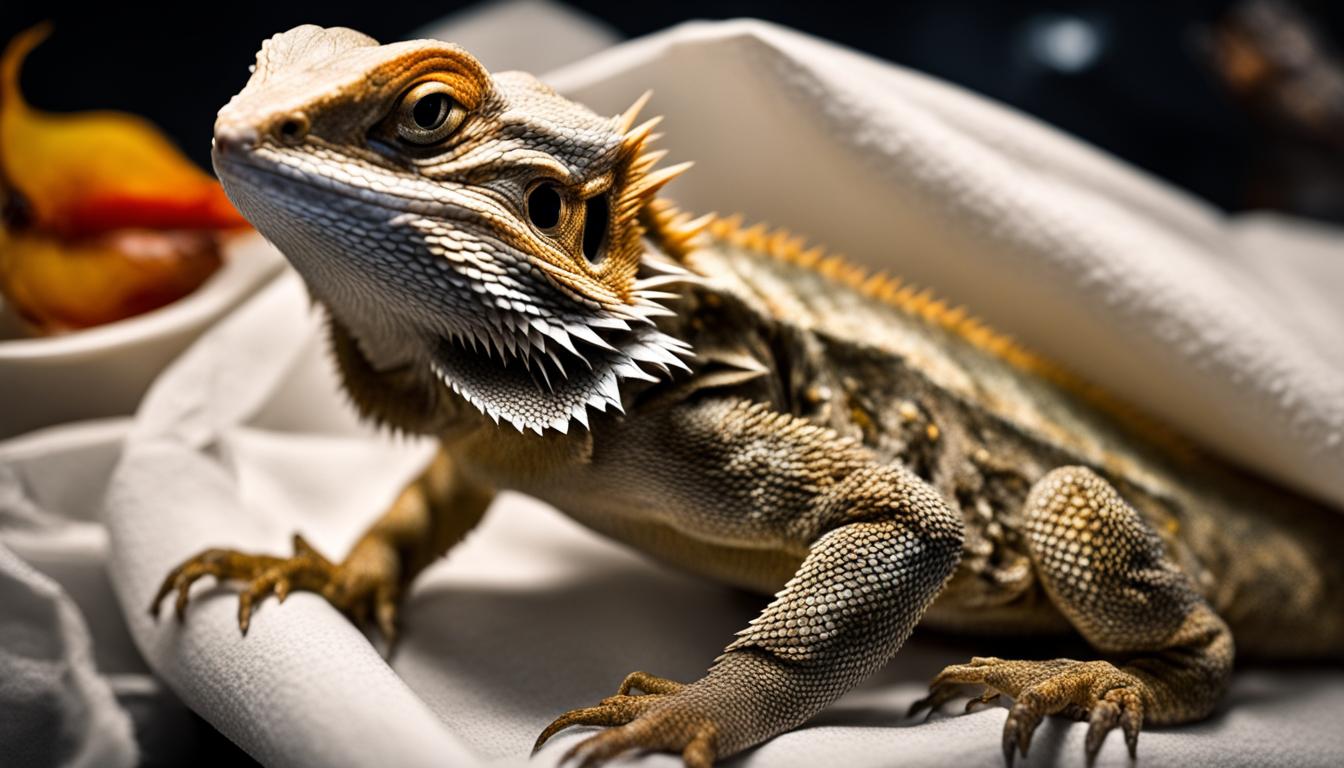Bearded dragons are beloved reptilian pets known for their unique appearance and friendly nature. However, these fascinating creatures are susceptible to various health issues, including respiratory infections. It is essential for bearded dragon owners to be aware of the signs, causes, and preventive measures to ensure their pets’ well-being.
Respiratory infections in bearded dragons can be caused by poor habitat conditions, such as low temperatures and high humidity, as well as stress from an improper setup. These infections can result in respiratory illness, leading to discomfort and potential complications.
Recognizing the signs of a respiratory infection is crucial in providing timely care for your bearded dragon. Some common symptoms include gaping, breathing difficulties, puffing up of the body or throat, excess mucus around the mouth and nostrils, appetite loss, and lethargy. If you notice any of these signs, it is essential to consult a veterinarian for diagnosis and treatment.
To prevent respiratory infections, bearded dragon owners should ensure proper habitat maintenance. This includes maintaining temperatures above 80 degrees Fahrenheit and monitoring humidity levels. Regular cleaning of the enclosure and providing a balanced diet are also important to support your pet’s overall health.
If a respiratory infection does occur, it is essential to seek veterinary care. Treatment may involve antibiotics to eliminate the infection and supportive measures to aid in recovery. With the right care and attention, most bearded dragons can overcome respiratory infections and regain their vitality.
Key Takeaways
- Respiratory infections are common in bearded dragons and can be caused by poor habitat conditions and stress.
- Signs of respiratory infection include breathing difficulties, excess mucus, and decreased appetite.
- Maintaining proper temperature and humidity levels in the habitat is crucial in preventing respiratory infections.
- If a respiratory infection occurs, prompt veterinary attention and treatment with antibiotics are necessary.
- Regular cleaning of the enclosure and providing a balanced diet can help prevent respiratory infections in bearded dragons.
Common Diseases of Bearded Dragons
Bearded dragons are fascinating and resilient creatures that make popular pets. However, despite their hardiness, they are not immune to health issues. It is important for bearded dragon owners to be aware of the common diseases that can affect these reptiles in order to provide them with the best possible care.
Respiratory Infections
Respiratory infections are a common health concern among bearded dragons. These infections can be caused by bacteria, viruses, fungi, or parasites, and may result in symptoms such as labored breathing, nasal discharge, or wheezing. Prompt veterinary attention is crucial in diagnosing and treating respiratory infections to prevent further complications.
Metabolic Bone Disease (MBD)
Metabolic Bone Disease is a serious condition that can occur in bearded dragons due to calcium and vitamin D3 deficiencies. This disease weakens the bones, leading to deformities, fractures, and muscle weakness. Providing a balanced diet and ensuring proper supplementation can help prevent MBD in bearded dragons.
Parasitic Infections
Parasitic infections, such as mites or intestinal parasites, can cause significant health problems in bearded dragons. These parasites can weaken the immune system, leading to lethargy, weight loss, and digestive issues. Regular fecal examinations and preventative treatments are essential to keep bearded dragons parasite-free.
Infectious Stomatitis (Mouth Rot)
Infectious stomatitis, commonly known as mouth rot, is an infection that affects a bearded dragon’s mouth and gums. It is often caused by poor oral hygiene or injuries to the mouth. Symptoms may include swelling, redness, and the formation of pus or lesions. Prompt veterinary care is necessary to treat this painful condition.
CANV (Chrysosporium anamorph of Nannizziopsis vreisii)
CANV, also known as Yellow Fungus Disease, is a fungal infection that primarily affects the skin and nails of bearded dragons. It can lead to discolored patches, thickened skin, and lethargy. Veterinary treatment is essential in managing this persistent and potentially fatal disease.
Atadenovirus Infection
Atadenovirus is a highly contagious and potentially lethal viral infection in bearded dragons. It can cause a variety of symptoms, including lethargy, weight loss, diarrhea, and neurological signs. Currently, there is no cure for atadenovirus, so proper biosecurity measures and quarantine protocols are crucial to prevent its spread.
Bearded Dragon Respiratory Infections
Respiratory infections, including pneumonia, can be a serious concern for bearded dragons. These infections are often the result of stress, improper nutrition, or poor habitat conditions. Bearded dragons with weakened immune systems are more susceptible to respiratory infections caused by bacteria, viruses, fungi, or parasites.
It is important for bearded dragon owners to be aware of the signs of respiratory infections. Some common symptoms include:
- Sneezing
- Discharge from the eyes or nose
- Bubbles from the mouth or nose
- Rapid or shallow breathing
- Open-mouthed breathing
- Decreased appetite
- Lethargy
If you notice any of these signs in your bearded dragon, it is crucial to seek prompt veterinary attention. Respiratory infections can quickly worsen and lead to severe respiratory distress if left untreated.

Table: Treatment Options for Bearded Dragon Respiratory Infections
| Treatment | Description |
|---|---|
| Antibiotics | Prescribed to target bacterial infections and restore respiratory health. |
| Supportive Care | Includes providing a warm and humid environment to ease breathing and maintaining proper hydration and nutrition. |
| Isolation | Isolating the infected bearded dragon from other reptiles to prevent the spread of the infection. |
| Medication | Administering medication to reduce inflammation and support the immune system. |
| Environmental Changes | Ensuring proper habitat conditions, including temperature and humidity, to support respiratory health. |
Early detection and treatment are crucial for the successful management of respiratory infections in bearded dragons. Prompt veterinary attention and a comprehensive treatment plan, including antibiotics and supportive care, can greatly improve the chances of a full recovery.
Taking Preventive Measures
Preventing respiratory infections in bearded dragons starts with providing them with a suitable habitat. Here are some preventive measures:
- Maintain proper temperature and humidity levels within their enclosure.
- Regularly clean the enclosure to minimize the risk of bacteria or fungal growth.
- Provide a balanced diet to support a strong immune system.
- Minimize stress by avoiding sudden changes in the environment.
- Quarantine new dragons to prevent the introduction of potential infections to the existing colony.
By implementing these preventive measures, you can reduce the risk of respiratory infections and ensure the overall well-being of your bearded dragon.
Causes of Pneumonia in Bearded Dragons
Bearded dragons are prone to respiratory infections, and pneumonia is a common illness that affects them. These infections often occur due to a weakened immune system caused by poor habitat conditions. Inadequate temperatures and humidity levels can contribute to the development of respiratory issues in bearded dragons. Research suggests that the presence of viral and bacterial infections together can lead to persistent cases of pneumonia in these reptiles.
Various viruses, including adenovirus and nidovirus, have been found to be associated with pneumococcal infections in bearded dragons. Additionally, bacteria such as Chlamydia pneumoniae and Mycoplasma spp. are commonly linked to respiratory infections in these reptiles. Identifying the underlying cause of pneumonia is crucial for determining the appropriate treatment plan, which may include the use of antibiotics to combat the bacterial infection.

Viruses and Bacteria Associated with Pneumonia in Bearded Dragons
| Virus | Bacteria |
|---|---|
| Adenovirus | Chlamydia pneumoniae |
| Nidovirus | Mycoplasma spp. |
Proper diagnosis of the specific viral or bacterial infection causing pneumonia is crucial for effective treatment. Veterinarians can perform tests, such as blood tests and cultures of eye/nose/oral discharges, to identify the culprit. Once the cause is determined, appropriate antibiotics or antiviral medications can be prescribed to target the specific infection, helping the bearded dragon recover and regain its health.
Quarantine Measures to Prevent Pneumonia in Bearded Dragons
- Isolate new bearded dragons for at least two weeks to monitor their health and prevent the spread of potential infections.
- Clean and disinfect all reptile enclosures, equipment, and accessories regularly to minimize bacterial and viral contamination.
- Avoid direct contact between bearded dragons and other reptiles that may carry or transmit infections.
Early intervention is crucial in treating and preventing pneumonia in bearded dragons. By ensuring proper habitat conditions, regular veterinary check-ups, and prompt treatment of respiratory infections, bearded dragon owners can help their beloved pets stay healthy and thrive.
Preventing and Treating Respiratory Infections
Preventing respiratory infections in bearded dragons is crucial for maintaining their health and well-being. By following a few essential care tips, you can minimize the risk of respiratory problems and ensure a happy life for your scaly companion.
Maintaining Habitat Conditions
Proper habitat maintenance plays a vital role in preventing respiratory infections in bearded dragons.
- Temperature: Bearded dragons require temperatures above 80 degrees Fahrenheit to stay healthy. Provide them with a basking spot where they can regulate their body temperature effectively.
- Humidity: Maintaining appropriate humidity levels is essential. Bearded dragons require a moderate level of humidity, but excessive humidity can lead to respiratory issues. Regularly monitor and adjust humidity levels in the habitat.
- Cleanliness: A clean habitat is crucial for preventing the growth of bacteria and other harmful microorganisms. Regularly clean and disinfect the enclosure, removing any waste or debris.
Diet and Nutrition
A balanced diet is key to maintaining a strong immune system in bearded dragons. Proper nutrition can help prevent respiratory infections and other health issues.
- Feed a variety of nutritious foods: Offer a diverse diet consisting of fresh vegetables, fruits, and live insects. This will provide the essential nutrients needed for a healthy bearded dragon.
- Avoid feeding unsafe foods: Some foods, such as spinach and iceberg lettuce, can be harmful to bearded dragons and contribute to respiratory problems. Research and avoid feeding foods that are known to be unsafe.
- Supplements: Use calcium and vitamin supplements, as recommended by a reptile veterinarian, to ensure your bearded dragon receives all the necessary nutrients.
Seeking Veterinary Care
If you notice any signs of a respiratory infection in your bearded dragon, it is crucial to consult with a reptile veterinarian as soon as possible. Early detection and treatment are essential for a successful recovery.
- Signs of respiratory infection in bearded dragons include:
- Sneezing
- Discharge from the eyes or nose
- Bubbles from the mouth or nose
- Rapid or shallow breathing
- Open-mouthed breathing
- Decreased appetite
- Lethargy
The veterinarian may recommend the following treatments:
- Antibiotics: Antibiotics are commonly prescribed to treat bacterial respiratory infections in bearded dragons. Follow the veterinarian’s instructions carefully.
- Supportive therapy: The veterinarian may provide additional treatments, such as fluid therapy or nebulization, to support the bearded dragon’s respiratory system.
- Lifestyle changes: Making necessary adjustments to the bearded dragon’s habitat, diet, and overall care can help improve their health and reduce the risk of recurrent infections.

| Preventive Measures | Treatment Options |
|---|---|
| Maintain appropriate temperature and humidity levels | Antibiotics |
| Clean and disinfect the habitat regularly | Supportive therapy |
| Feed a balanced diet | Lifestyle changes |
Diagnosing Respiratory Infections in Bearded Dragons
Proper diagnosis plays a crucial role in effectively treating respiratory infections in bearded dragons. Veterinary professionals employ a combination of diagnostic methods to identify the specific cause of the infection and determine the most appropriate treatment plan.
Diagnostic Methods
Diagnostic methods for respiratory infections in bearded dragons may include:
- Radiographs (X-rays): X-rays provide valuable insights into the respiratory system, allowing veterinarians to assess the condition of the lungs and air sacs.
- Blood tests: Blood tests help identify any abnormalities in the blood count or detect the presence of bacterial or viral infections.
- Cultures of eye/nose/oral discharges or other samples: Collecting and analyzing samples from the affected areas can help pinpoint the specific pathogens responsible for the infection.
These diagnostic methods help veterinarians determine the nature of the infection and choose the most appropriate treatment strategy.
Treatment Approaches
The treatment for respiratory infections in bearded dragons depends on the underlying cause. Here are the common treatment approaches:
- Oral or injectable antibiotics: Bacterial infections are a common cause of respiratory infections in bearded dragons. Antibiotics, such as enrofloxacin or doxycycline, are often prescribed to combat the bacterial pathogens.
- Antifungal, antiviral, or antiparasitic medications: In cases where the infection is caused by fungi, viruses, or parasites, specific medications targeting these pathogens may be prescribed.
It’s important to note that each treatment plan is tailored to the individual dragon’s condition and the specific pathogens involved.
Next-Generation Sequencing (NGS)
“Next-generation sequencing (NGS) has revolutionized diagnostic capabilities in veterinary medicine by enabling the identification and analysis of the microbial makeup of respiratory infections in bearded dragons. NGS allows veterinarians to obtain a comprehensive understanding of the microorganisms involved, leading to more targeted and effective treatment strategies.”
NGS is a clinical diagnostic method that has shown promise in identifying the microbial composition of respiratory infections in bearded dragons. By analyzing the genetic material of the pathogens present, NGS can provide valuable insights into the specific strains and variations involved in the infection. This allows veterinarians to develop tailored treatment plans that address the unique characteristics of each infection.
With the help of diagnostic techniques like radiographs, blood tests, cultures, and emerging methods like NGS, veterinarians can accurately identify and treat respiratory infections in bearded dragons, improving their chances of recovery and overall well-being.
| Diagnostic Methods | Treatment Approaches |
|---|---|
| Radiographs (X-rays) | Oral or injectable antibiotics |
| Blood tests | Antifungal, antiviral, or antiparasitic medications |
| Cultures of eye/nose/oral discharges or other samples |
Conclusion
Proper care and maintenance are essential for ensuring the health and well-being of bearded dragons. By following a few simple steps, owners can greatly reduce the risk of respiratory infections in their scaly friends. Maintaining the appropriate temperature and humidity levels in the habitat is crucial, as this helps to create an environment that is inhospitable to harmful bacteria and viruses.
Additionally, providing a proper diet rich in essential nutrients and vitamins strengthens the immune system and helps the bearded dragons fight off infections. Regular cleaning and sanitization of the habitat is also essential to prevent the buildup of harmful bacteria and promote a healthy living environment.
If a respiratory infection does occur, it is important to seek prompt veterinary attention. Veterinarians experienced in reptile care can provide a proper diagnosis and recommend the necessary treatment, which may include antibiotics and supportive care. By being proactive and attentive to their bearded dragon’s health, owners can help ensure a long and happy life for their beloved pets.
FAQ
What are the signs of respiratory infection in bearded dragons?
Signs of respiratory infection in bearded dragons include gaping, breathing difficulties, puffing up the body or throat, excess mucus around the mouth and nostrils, appetite loss, and lethargy.
How can I prevent respiratory infections in my bearded dragon?
Proper habitat maintenance, including maintaining temperatures above 80 degrees Fahrenheit and monitoring humidity levels, is crucial in preventing respiratory infections. Keeping the habitat clean and providing a proper diet are also important preventive measures.
What should I do if my bearded dragon has a respiratory infection?
If your bearded dragon has a respiratory infection, it is important to consult with a veterinarian as soon as possible. Treatment may involve antibiotics, supportive therapy, and lifestyle changes to improve the bearded dragon’s overall health and reduce the risk of recurrent infections.
Are respiratory infections in bearded dragons treatable?
Yes, respiratory infections in bearded dragons can be treated. Prompt veterinary attention and aggressive therapy, including the use of antibiotics, are necessary for effective treatment.
How are respiratory infections in bearded dragons diagnosed?
Diagnosing respiratory infections in bearded dragons may involve radiographs (X-rays), blood tests, and cultures of eye/nose/oral discharges or other samples. Next-generation sequencing (NGS) is a promising diagnostic method that can help identify the underlying cause of the infection.


